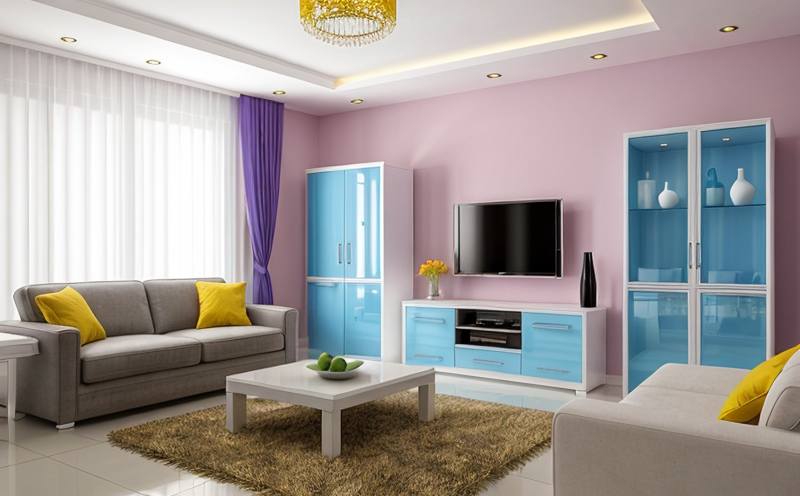UL 94 Flammability Classification Testing of Home Decorative Plastics
The UL 94 flammability classification is a widely recognized standard that evaluates the fire resistance of plastics. In particular, it focuses on determining the flammability of home decorative plastics used in various applications such as furniture, lighting fixtures, and electrical components. This test ensures that materials meet safety standards, protecting consumers from potential hazards.
Home decoration plastics are essential for interior design and functionality within residential environments. They must be evaluated against stringent fire safety criteria to ensure they do not pose a risk when exposed to flames. The UL 94 standard provides a framework for testing these plastics under controlled conditions, ensuring consistent results that can be relied upon.
The testing process involves subjecting the plastic specimens to specific heat and flame exposure levels defined by the UL 94 specifications. Specimens are categorized into different groups based on their performance in these tests. For example, Group V-2 is one of the most stringent classifications, requiring materials to extinguish any flaming after removal from the source of ignition.
Compliance with this standard ensures that home decoration plastics meet rigorous fire safety requirements set by regulatory bodies like Underwriters Laboratories (UL). This compliance enhances product quality and consumer confidence in the safety features of these products. Additionally, it supports sustainable practices by promoting safer alternatives to more hazardous materials.
Testing laboratories play a crucial role in ensuring accurate and reliable UL 94 flammability classification results. They use advanced instrumentation capable of replicating real-world scenarios accurately while maintaining precision throughout each test run. Proper specimen preparation is also critical; this includes selecting appropriate dimensions, thicknesses, surface finishes, and orientations that represent actual product configurations.
Accurate reporting plays a vital role in the UL 94 testing process. Detailed reports include information on material composition, test parameters, observed behavior during testing, and final classification results. These reports provide valuable insights for manufacturers who aim to improve their products' performance while adhering strictly to regulatory guidelines.
In summary, UL 94 flammability classification testing is an indispensable tool in ensuring the safety of home decoration plastics used in residential settings. By following this standard's rigorous procedures and interpreting results correctly, laboratories help maintain high standards of product quality and consumer protection across all sectors.
Scope and Methodology
The UL 94 flame test is designed to evaluate the flammability of plastics by subjecting them to controlled environments where they are exposed to heat and flames. This testing process helps identify how quickly or slowly a particular plastic melts, burns, drips, and extinguishes after being removed from the source of ignition.
- Group V-2: Requires materials to self-extinguish without dripping after 10 seconds of flame application.
- Group H: Similar to V-2 but allows up to 30 seconds for self-extinction and no dripping.
The test apparatus consists of a standard burner, timer, and holder for the specimen. The burner produces a specified height of flame that applies consistent heat and duration to the material being tested. Specimens are typically cut into specific shapes such as discs or blocks depending on the group they belong to.
| Test Group | Flame Duration (Seconds) | Drip Allowance |
|---|---|---|
| V-2 | 10 | No dripping allowed |
| H | 30 | Allowable dripping |
The entire procedure is conducted under strict laboratory conditions to ensure accuracy and repeatability. Each specimen undergoes multiple trials to account for variability in results due to factors such as manufacturing tolerances or environmental influences.
Benefits
Compliance with the UL 94 standard offers numerous advantages, particularly for manufacturers of home decorative plastics. By adhering to these stringent fire safety requirements, companies can:
- Enhance product quality and reliability.
- Increase market acceptance by meeting international safety standards.
- Reduce liability risks associated with non-compliant products.
- Promote sustainable practices by choosing safer alternatives over potentially hazardous materials.
Besides benefiting manufacturers directly, compliance also contributes positively to public health and safety. It ensures that consumers are not exposed to unsafe products that could pose a fire hazard in their homes or offices. Furthermore, it fosters trust between businesses and regulatory bodies responsible for enforcing such standards.
Overall, UL 94 flammability classification testing is an essential step towards creating safer environments both at home and in commercial spaces. It demonstrates commitment to excellence while providing peace of mind for all stakeholders involved in the production chain.
Industry Applications
The UL 94 flammability classification plays a crucial role across various industries where home decorative plastics are used extensively. Here are some key sectors where this testing is particularly relevant:
- Furniture Manufacturing: Ensures that cushioning materials and upholstery fabrics comply with fire safety standards.
- Lighting Fixtures: Guarantees that components like LED lenses and enclosures meet rigorous flame retardancy requirements.
- Electrical Appliances: Protects against potential fires caused by overheating or short circuits in wiring systems.
In furniture manufacturing, home decoration plastics are often used for cushioning materials due to their comfort properties. Ensuring these materials pass the UL 94 tests is vital because they come into direct contact with users and must not ignite easily. Similarly, lighting fixtures use decorative plastics that need to withstand high temperatures without catching fire or spreading flames rapidly.
For electrical appliances, the choice of home decoration plastics extends beyond mere aesthetics; it involves selecting materials that can endure rigorous operational conditions while maintaining integrity under extreme heat. By undergoing UL 94 testing, manufacturers ensure their products meet essential safety criteria, thereby protecting end-users from potential risks associated with flammable materials.
The table below summarizes the various applications of home decoration plastics subjected to UL 94 testing:
| Sector | Purpose of Material Use |
|---|---|
| Furniture Manufacturing | Cushioning materials, upholstery fabrics |
| Lighting Fixtures | LED lenses, enclosures |
| Electrical Appliances | Wiring systems components |
The consistent application of UL 94 testing across these industries ensures that home decoration plastics remain safe and reliable throughout their lifecycle.





